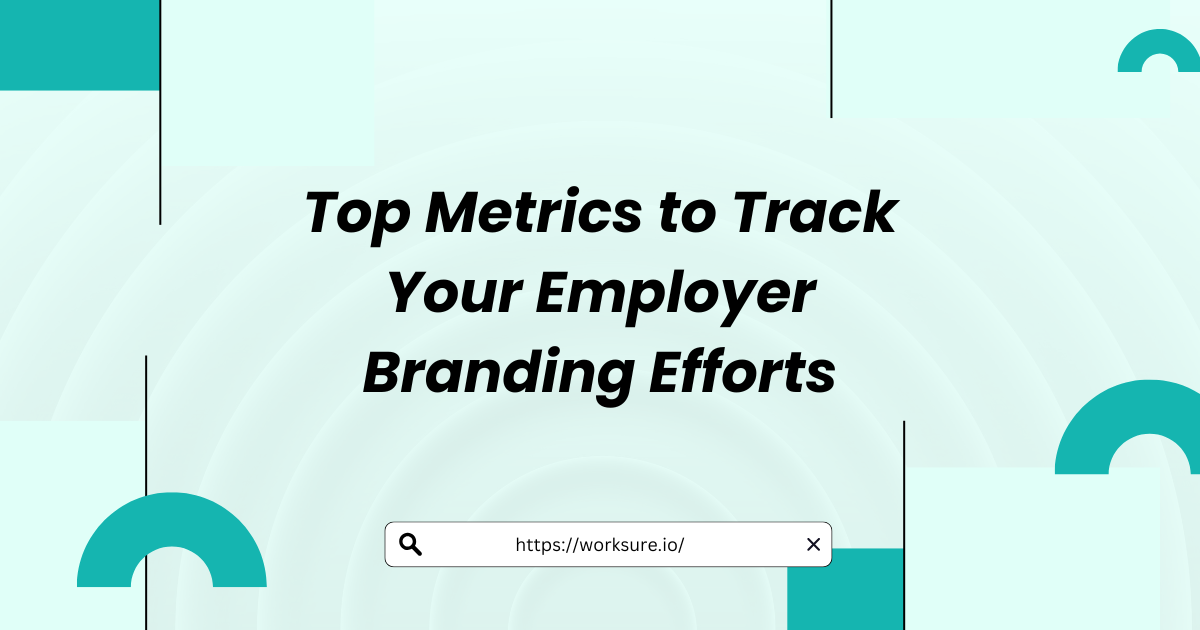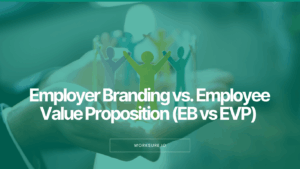Table of Contents
You wouldn’t run a marketing campaign without measuring conversions, so why invest in employer branding without tracking its impact?
Employer branding isn’t just about career pages and culture videos, it’s about measurable influence on hiring, retention, and perception. And yet, most teams overlook the metrics that reveal whether their efforts are truly paying off.
This guide outlines the top metrics to track your employer branding efforts so you can understand what’s working, where you need to improve, and how your employer brand is helping, or hurting, your hiring and retention goals.
Before you track performance, it’s important to define what employer branding actually is.
What is Employer Branding?
Employer branding refers to how your organization is perceived as an employer by both current employees and potential candidates. It encompasses everything from your company culture and leadership style to your benefits, values, work environment, and how these are communicated externally.
Why You Need to Track Employer Branding Metrics
A strong employer brand influences how easily you attract qualified candidates, how long positions stay open, how engaged your employees are, and how likely they are to stay.
When executed well, employer branding can:
- Attract more qualified applicants
- Reduce time and cost per hire
- Increase offer acceptance rates
- Improve employee retention and satisfaction
However, these outcomes don’t happen by chance. Without tracking the right employer branding metrics, it’s impossible to know whether your efforts are working, or where adjustments are needed.
Top Metrics to Track Employer Branding Efforts
Tracking employer branding requires a structured approach. Grouping metrics into key categories allows you to evaluate performance across the full candidate and employee lifecycle. Here is a list of the most important metrics to track employer branding efforts:
- Visibility Metrics (Are people seeing your brand?)
- Reputation Metrics (How do people feel about your brand?)
- Hiring Metrics (Are you attracting the right candidates?)
- Retention Metrics (Are employees staying because of your brand?)
- Strategic Metrics (What’s the long-term brand impact?)
Let’s look at each of these in detail below.
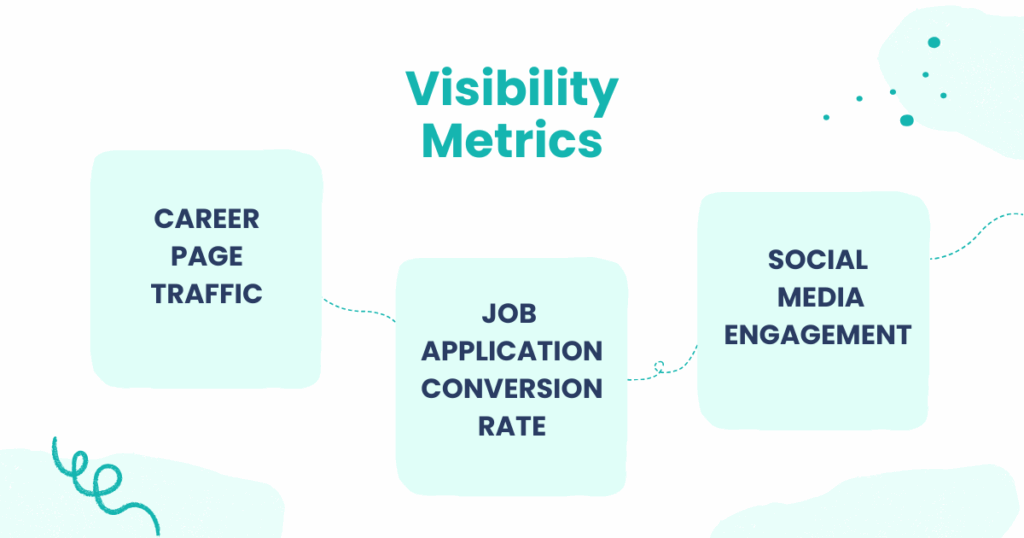
1. Visibility Metrics (Are People Seeing Your Brand?)
Visibility metrics help you assess the reach of your employer brand across your digital channels. These indicators reflect whether your branding efforts are creating awareness and attracting attention from potential candidates.
Without visibility, even the strongest employer value proposition is unlikely to generate results.
Career Page Traffic
Your careers page is often the first point of contact between your brand and a potential candidate. Tracking traffic to this page provides insight into how many individuals are exploring opportunities at your organization. Monitor the following indicators:
- Total visits over time
- Bounce rate
- Time spent on page
- Navigation paths to and from job listings
Use tools such as Google Analytics or Hotjar to understand user behavior and identify areas for improvement.
Job Application Conversion Rate
This metric measures how many visitors to your careers page complete a job application. It reflects the effectiveness of your job content, application experience, and overall value proposition.
A low conversion rate may indicate lengthy or complex application processes, unclear job descriptions and lack of differentiation in your employer offering
Improving clarity, reducing friction in the application process, and highlighting unique benefits can contribute to higher conversion rates. This metric should be tracked consistently to evaluate changes made over time.
Social Media Engagement
Social media platforms are key channels for employer brand visibility. Engagement metrics such as likes, comments, shares, and click-through rates help assess whether your content is reaching and resonating with the intended audience.
Focus on:
- Post reach and impressions
- Engagement rates by content type
- Click-through rates to careers content or job listings
A steady level of engagement indicates that your messaging is relevant and effectively targeted. Low engagement may suggest a need to adjust your content themes, format, or frequency.
Use platform-specific tools such as LinkedIn Analytics, Hootsuite, or Sprout Social to track performance and identify high-performing content.
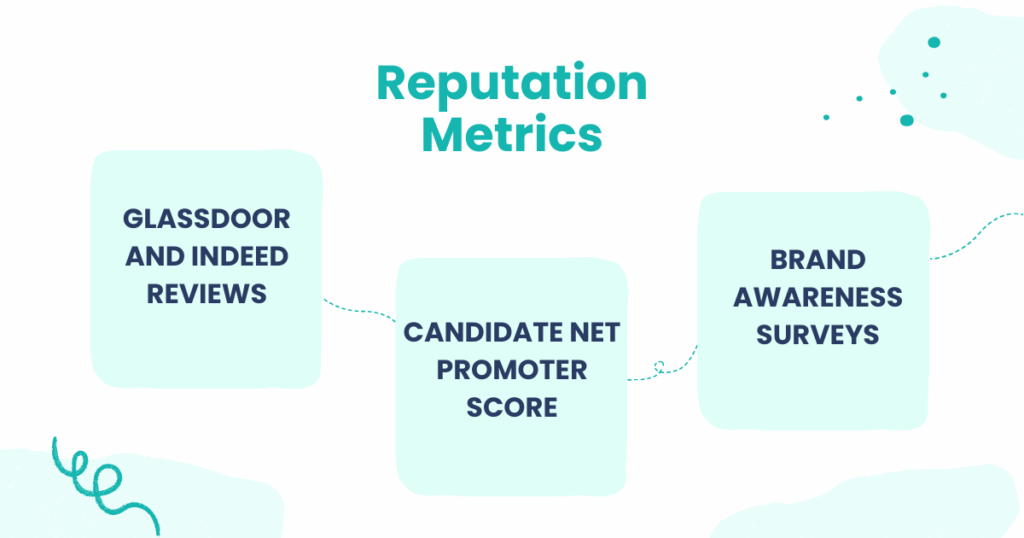
2. Reputation Metrics (How Do People Feel About Your Brand?)
While visibility measures awareness, reputation reflects sentiment—how candidates and employees interpret and react to your brand. These insights are critical for identifying gaps between the intended employer brand and the actual experience.
Glassdoor and Indeed Reviews
Online reviews on platforms such as Glassdoor and Indeed provide direct, unfiltered feedback from current and former employees. They influence candidate perception and often play a key role in the decision to apply. Track the following:
- Average rating over time
- Volume and consistency of reviews
- Recurring themes in written feedback
A consistently low rating may indicate unresolved internal issues, while a trend of improving reviews can reflect progress in workplace culture or leadership practices. Responding to reviews, especially negative ones, with professionalism and transparency reinforces a message of accountability.
Candidate Net Promoter Score (cNPS)
The candidate Net Promoter Score measures how likely candidates are to recommend applying to your company. It reflects the overall interview experience and perception of your brand during the hiring process.
Ask candidates: “How likely are you to recommend applying to [Company] to a friend or colleague?” (0–10 scale)
Collecting additional open-ended feedback helps identify specific pain points or strengths in the candidate journey. Tracking cNPS consistently can inform improvements in recruitment experience and alignment with brand messaging.
Brand Awareness Surveys
Brand awareness surveys help gauge how well your employer brand is recognized in the talent market and what associations people make with your company.
These surveys can be distributed via LinkedIn, email, job boards, or at recruitment events. Comparing results across periods or target groups can highlight whether awareness is improving and if perceptions align with your intended positioning.
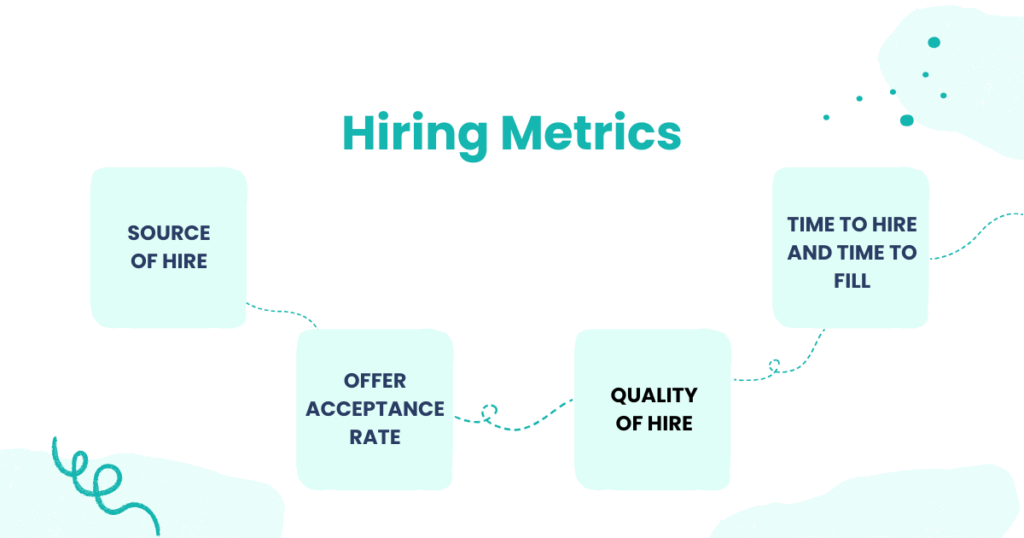
3. Hiring Metrics (Are You Attracting the Right Candidates?)
A strong brand should not only generate interest but also attract top talent, improve offer acceptance, and reduce the time to hire. These indicators help assess both the reach and quality of your hiring efforts.
Source of Hire
Understanding where your candidates are coming from allows you to evaluate which channels contribute most to attracting suitable talent. This includes job boards, employee referrals, social media, the company website, or recruitment agencies.
To measure this metric effectively, track the following:
- Number of hires per source
- Performance or retention of hires by source
- Cost associated with each channel
Analyzing source data helps prioritize investments in high-performing channels and identify areas where employer branding efforts are producing tangible hiring outcomes.
Offer Acceptance Rate
This metric indicates the percentage of job offers accepted by candidates. A high acceptance rate generally suggests a strong employer brand, competitive offers, and a positive candidate experience.
A lower rate may point to misalignment between candidate expectations and the actual role, compelling offers from competitors or communication gap during the hiring process.
Monitoring this metric can help identify trends by role type, department, or region.
Time to Hire and Time to Fill
Time to fill measures the number of days between posting a role and filling it while time to hire measures the duration from initial candidate contact to offer acceptance.
Extended timelines may indicate branding challenges, lack of visibility, or poor candidate fit. A strong employer brand often results in faster, more efficient recruitment.
Consistently tracking these metrics supports workforce planning and helps identify where the recruitment process may need to be streamlined through improved branding.
Quality of Hire
Quality of hire evaluates the performance and retention of new employees. It provides insight into whether your employer brand is attracting individuals who are well-suited for the role and organization. Indicators include:
- Hiring manager satisfaction scores
- New hire performance ratings
- Retention after 6–12 months
Collecting feedback from both managers and employees helps assess whether expectations set during the hiring process are being met, and whether branding efforts are aligned with actual workplace culture.
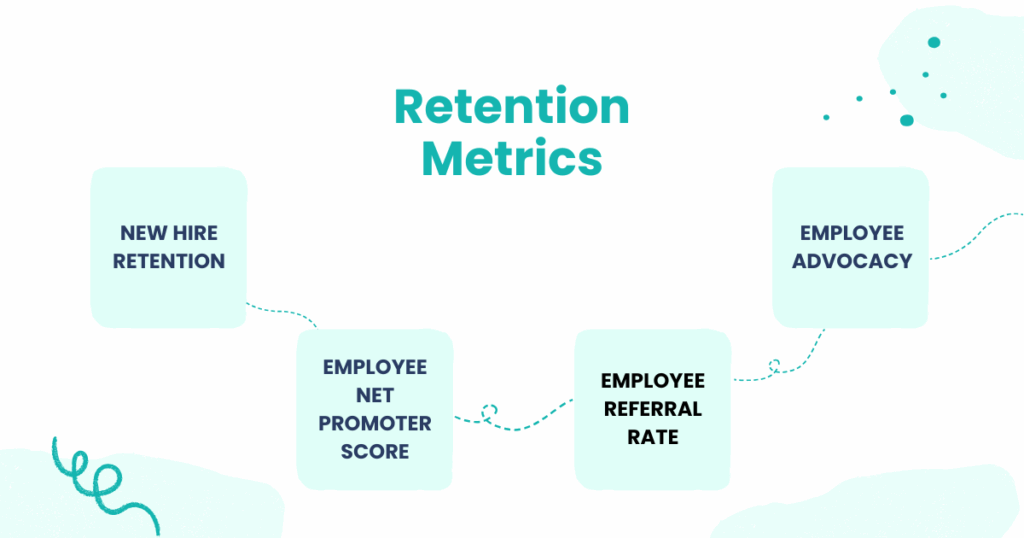
4. Retention Metrics (Are Employees Staying Because of Your Brand?)
These metrics help determine whether your internal culture aligns with external messaging, and whether employees are motivated to stay and contribute long term.
New Hire Retention
Early turnover is often a signal of misalignment between candidate expectations and actual experience. Monitoring new hire retention at 30, 60, and 90 days provides early insight into onboarding effectiveness and brand consistency.
Track percentage of new hires still employed after 30/60/90 days and collect feedback from exit interviews or early-stage check-ins.
High early turnover may indicate gaps in communication, unclear role expectations, or a disconnect between employer branding and workplace reality.
Employee Referral Rate
A high referral rate typically reflects a strong internal brand. Employees are more likely to refer peers when they are confident in the organization’s culture, leadership, and overall employee experience.
Monitor number of referrals per employee or department, referral-to-hire ratio and performance and retention of referred candidates.
Consistently tracking this metric helps evaluate brand trust from within and may also improve hiring efficiency and quality.
Employee Advocacy
Track how many employees are sharing company content or promoting your brand on LinkedIn or other channels. This organic visibility is one of the most powerful signals of a strong brand. Tools like LinkedIn Employee Notifications or advocacy platforms can help measure this.
High levels of advocacy suggest that employees feel aligned with the brand and are willing to promote it externally, reinforcing brand credibility with potential candidates.
5. Strategic Metrics: Long-Term Brand Value
While visibility, hiring, and retention metrics reflect operational outcomes, strategic metrics provide insight into alignment, consistency, and brand equity over time. These indicators support high-level decision-making and long-term planning.
Brand Sentiment
Brand sentiment reflects the tone of conversations and content associated with your company as an employer. It offers insight into whether your brand is viewed positively, neutrally, or negatively across external platforms.
Monitoring sentiment helps ensure that public perception is aligned with your intended positioning and allows early identification of reputational risks.
EVP Feedback
Your employer value proposition (EVP) defines the key benefits and values you offer to employees. Tracking feedback on your EVP helps measure how well these promises are understood, and whether they are being delivered.
Common focus areas include flexibility, leadership, career growth, and purpose. A disconnect between the EVP and day-to-day employee experience can affect both retention and employer reputation.
Final Thoughts
Measuring employer branding is essential to improving how your organization attracts, hires, and retains talent. The right metrics offer clarity on performance and help align brand perception with business goals.
You don’t need to track everything at once. Start with 5–7 key metrics that matter most to your hiring and retention goals. As you gather more data, you can refine your strategy, improve candidate experiences, and create a stronger brand that attracts and keeps top talent.
For companies focused on building trust, tools like WorkSure reinforce your employer brand by making your hiring process transparent. Employment verification through WorkSure demonstrates a commitment to fairness and accountability, for both candidates and employers.
Related Articles:
